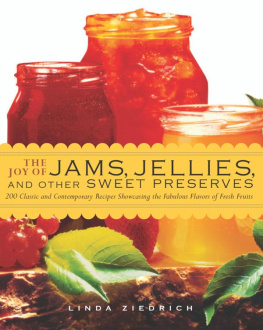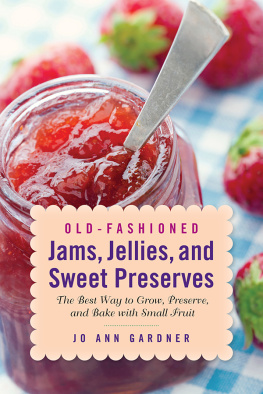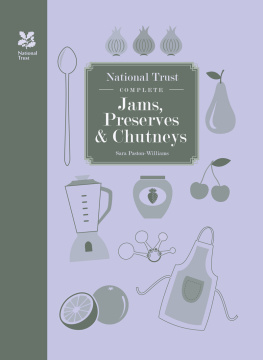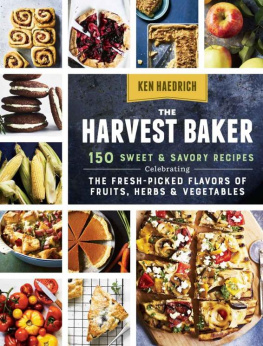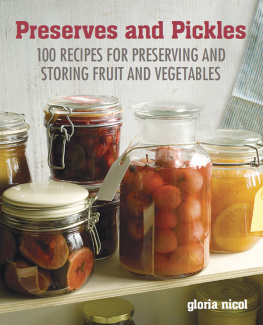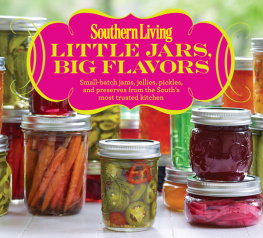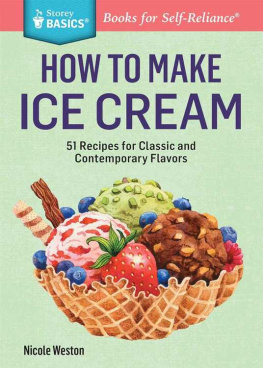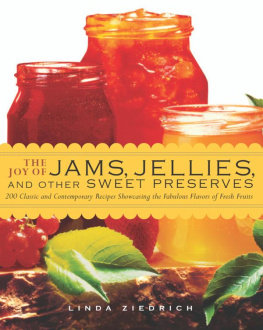The Harvard Common Press
535 Albany Street
Boston, Massachusetts 02118
www.harvardcommonpress.com
Copyright 2009 by Linda Ziedrich
All rights reserved. No part of this publication may be reproduced or transmitted in any form or
by any means, electronic or mechanical, including photocopying, recording, or any information
storage or retrieval system, without permission in writing from the publisher.
Printed in the United States of America
Printed on acid-free paper
Library of Congress Cataloging-in-Publication Data
Ziedrich, Linda.
The joy of jams, jellies, and other sweet preserves : 200 classic and contemporary recipes
showcasing the fabulous flavors of fresh fruits / Linda Ziedrich.
p. cm.
ISBN 978-1-55832-406-0 (pbk.)ISBN 978-1-55832-405-3 (hardcover)
1. Jam. 2. Jelly. I. Title.
TX612.J3Z54 2009
641.8'52dc22
2008036447
Special bulk-order discounts are available on this and other Harvard Common Press books.
Companies and organizations may purchase books for premiums or resale, or may arrange a
custom edition, by contacting the Marketing Director at the address above.
Cover design by Night & Day Design
Interior design by Ralph Fowler / rlf design
10 9 8 7 6 5 4 3 2 1
FOR REBECCA,
MY INTREPID FORAGER
Preface
I have been working on this book for so long that I can't remember why I started. But my inspiration must have come partially from a Yugoslavian immigrant I knew when both of us were barely into our twenties. On a hike he picked some blackberries or plums, and he made them into jam simply by cooking them with sugar, as he remembered his mother and grandmother doing. There was no trip to the supermarket for a package of pectin, no unfolding the long page of instructions and searching for the relevant oneswhich had to be followed exactly, the manufacturer always warned, or else the jam wouldn't set. My friend's success got me wondering how people made jams and jellies before pectin was packaged and sold in stores. I soon learned that many people still make jams and jellies the old-fashioned way, and that there are many traditional ways of preserving fruit that don't require gelling at all. For nearly three decades before writing this book, I researched and experimented with traditional preserving methods.
Because I am a native of California now living in western Oregon, most of the fruits and nuts I know come from these two states. For anyone who wants to explore North American fruits, the fecund Pacific states, and particularly California, are probably the best place to start. But because I want this book to be as valuable as possible to as many people as possible, I've also experimented with fruits from elsewhere, especially the tropics. If I've neglected fruits you know and love, or if I've left out your favorite ways of making them into sweet preserves, please feel free to write me in care of The Harvard Common Press, and I will keep your suggestions in mind for a second edition.
For their support in this project, I thank Bruce Shaw, Valerie Cimino, Karen Wise, and the whole staff at The Harvard Common Press; my family, who have had to taste everything in this book; and all the people who have patiently answered my questions about what they put into jars.
Introduction
Occasionally I'm asked why anyone in this modern world would still do home preserving. If you've picked up this book, you probably have many answers to that question. Even if you live in the middle of a big city, a bounty of free fresh fruit may sometimes fall into your handsfrom a single tree in your tiny backyard, perhaps, or lush vines along a nearby abandoned railroad. Perhaps your eyes prove bigger than your stomach at the farmers' market, and you can't bear to waste the precious, lovely fruit you've emptied your pockets for. You may despair at the bland taste of commercial preserves and challenge yourself to do better. Maybe you want to avoid the corn syrup or other questionable ingredients in supermarket products, or duplicate costly preserves in pretty jars from a fancy-foods shop. You may anticipate the delight on friends' faces when they dip into one of your jars at your breakfast table or find one under a Christmas tree. You may feel the strong sense of connectedness that comes from making jams and jellies just like your mother's and grandmother's, or from exchanging recipes and jars with your neighbors or with friends around the world.
Most compelling of all may be the sensations that flood your mouth, and feelings that flood your mind, every time you taste your own well-made preserves. A jar of jam or jelly is a memory brought back to life, less bright than the original, but sweeter and mellower. The jar is also a promiseof the fresh flavors that will greet your tongue in a few short months and, if you're lucky, again every year thereafter.
PRESERVER'S PRIMER
S OME PEOPLE go about cooking by first reading recipes and then shopping for ingredients. Home preservers don't do that; they read recipes to learn what to do with the produce they already have. For this reason, this book is arranged alphabetically by type of fruit. The notes preceding each section will tell you a little about the history, varieties, growing conditions, harvest, and preparation of the particular fruit.
KINDS OF PRESERVES
This book includes recipes for several kinds of preserves, the names of which have varied over the centuries and from region to region. I have followed the most common contemporary American usage, with slight variation, as follows:
JAM. Crushed or chopped fruit that is cooked with sugar until the mixture gels, or "sets." I include in this category preserves made from pureed fruit, when the mixture is cooked quickly and without spices.
JELLY. A gelled mixture of sugar and juice, acidified if necessary. The kind of jelly that wins prizes at a county fair is clear, and it holds its shape when turned out of its container onto a dish. When the dish is moved, the jelly quivers. When the jelly is sliced, it retains the angle of the cut. Personally, I like softer, more spreadable jellies. Opaque jellies, such as milky-pink flowering-quince jelly, can also be very attractive.
MARMALADE. Jelly, usually soft and clear, in which are suspended pieces of fruit or citrus peel or both. Marmalade is often made entirely with citrus fruit. Because of the inclusion of the peel, citrus marmalades are usually bitter in flavor.
CONSERVE. Jam made from several ingredients, which may include two or more fresh fruits, nuts, and raisins.
BUTTER. Pureed fruit cooked slowly with sugar, juice, or both, usually with added spices, until the mixture is thick and dark. Butters generally have less added sugar than jams.
PRESERVES. In the narrow sense of the word, preserves are whole or sliced fruits in syrup or soft jelly. In the past, preserves were served as "spoon sweets" on their own for dessert, with or without their syrup. Today syrupy preserves are often served over cake or ice cream. For eating with bread, though, lightly gelled preserves are generally preferred. Preserves are called conserves in England.
SYRUP. A solution of fruit juice and sugar or honey. Syrups are usually, but not always, thick, clear, and ungelled. They are mixed with ice, water, and other liquids for drinks and poured over cake, ice cream, and other desserts.
PASTE. A mixture of pureed, pectin-rich fruit and sugar cooked until it is very thick, poured into wide dishes to dry, and served cut into pieces as a finger food. Sometimes the pieces are rolled in sugar. The most popular fruits for paste are quince and, in Latin America, guava. Quince paste was the original marmalade. The English, who make paste from many fruits, call it
Next page
